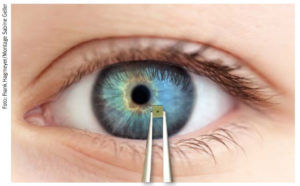With the flagship initiative “Trustworthy Electronics” of the Federal Ministry of Education and Research (BMBF), the federal government wants to make electronic components and systems more secure. Scientists from Ulm from the Institute for Microelectronics are involved in two projects that are funded through this initiative. You will receive a total of around one million euros for the development of an electronic “fingerprint” for electronic components in order to clearly identify individual components and integrated systems.
Electronics are taking on more and more safety-critical functions: whether in automated driving, in medical technology or in robot-supported industrial production. “Day after day, we trust that the technology will work perfectly. But how do we know whether the installed technical parts are rightly enjoying our trust? Because individual components could be counterfeit, manipulated or simply defective,” says Professor Maurits Ortmanns. The head of the Institute for Microelectronics at the university is involved in two joint projects that are funded with a total of over 22 million euros as part of the BMBF flagship initiative “Trustworthy Electronics”. The focus of this initiative is the guarantee of authenticity, functionality and security of supply with the long-term goal of securing the technological sovereignty of German economy and science.
The VE-VIDES project is developing a holistic security concept for electronic systems that is intended to protect against attacks, manipulation and product piracy. The aim is to make electronic components identifiable with a fingerprint. Use cases from the areas of autonomous driving and Industry 4.0 are dealt with. The results are then to be transferred to medical and communication technology as well as aerospace. A total of 16.3 million euros are available to those involved for the three-year duration of the research project.
A second joint project from the flagship initiative, in which Ulm University is also involved, has a similar thrust. Under the abbreviation VE-FIDES, it is also dedicated to the creation of digital identity. The focus is particularly on processes that make it possible to trace individual components and entire systems across the entire production chain. Proof of authenticity is intended to prevent counterfeit or inferior electronic parts from getting into circulation and being installed. VE-FIDES accounts for a total of 6 million euros, which are also available for 3 years.
The task of the Ulm scientists from the Institute for Microelectronics is to develop a forgery-proof physical “fingerprint” for electronic circuit boards, programmable circuits and integrated circuits (FPGA and microcontroller). The electronic fingerprint is intended to help find out whether a component is an original and whether it has been modified to damage the application or whether it has been counterfeited or illegally copied.
“Germany is a country of innovation. It is important that we assert ourselves in international competition when it comes to key technologies such as digitization,” emphasized Federal Research Minister Anja Karliczek, according to the BMBF report, when presenting the flagship initiative “Trustworthy Electronics”. Ultimately, the federal government’s “high-tech strategy” is about technological sovereignty and about realizing our own economical electronics production in Germany and Europe. The Ulm scientists are proud that they can make an important contribution to this.

